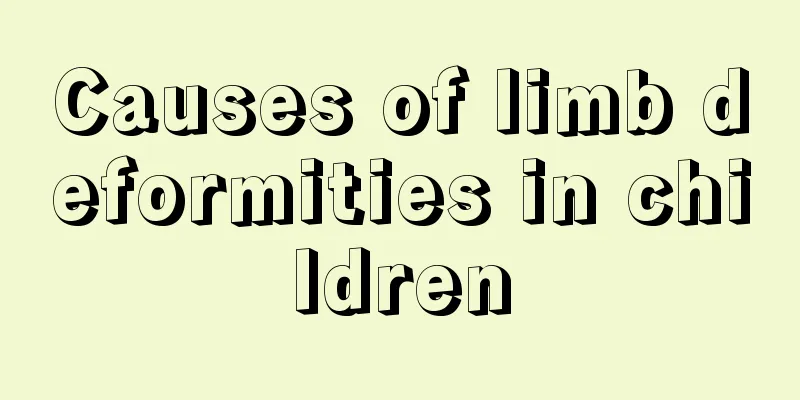Causes of limb deformities in children

|
Giving birth to a baby with deformed limbs is undoubtedly bad news for a family. Only by understanding the causes of children's limb deformities can we do a better job of prevention and prevent this kind of situation from happening. I believe this is a topic that every expectant father and mother is very concerned about. So what are the causes of children's limb deformities? Let's take a look at the answers given by the doctor, which can be divided into the following three points: (1) Genetic factors and congenital malformations Congenital malformations caused by genetic factors, including chromosomal aberrations and gene mutations, account for 25% of congenital malformations. Chromosomal aberrations include abnormalities in chromosome number or chromosome structure. Chromosomes are originally opposite to each other in pairs, and a reduction in their number can cause congenital malformations, the most common of which is the monosomy. Monosomal embryos with plant chromosomes can hardly survive, and only 3% of monosomal embryos with sex chromosomes survive, but they may have deformities, such as congenital ovarian dysgenesis, namely Turner syndrome (45, 0X). An increase in the number of chromosomes can also cause deformities, which is more common in trisomy. For example, the common congenital idiocy is caused by chromosome 21. Sex chromosome trisomy (47, XXY) can cause congenital testicular dysgenesis. Structural abnormalities of chromosomes can also cause deformities. For example, the deletion of the end of the short arm of chromosome 5 can cause "cat cry syndrome." In addition to causing a few deformities, such as achondroplasia, polycystic kidney disease, and polydactyly, gene mutations mainly cause metabolic genetic diseases. (2) Environmental factors and congenital malformations Environmental factors that can cause congenital malformations are collectively called teratogens, accounting for 10% of congenital malformations. There are three aspects of the environment that affect embryonic development, namely the external environment around the mother, the internal environment of the mother, and the microenvironment around the embryo. Some teratogens in the external environment can directly act on the embryo by changing the internal environment and microenvironment, while others can indirectly act on the embryo by changing the internal environment and microenvironment. The main environmental teratogens are biological, physical, chemical, and drug. The physical teratogens that have been confirmed so far include: radiation, mechanical compression and injury, high temperature, etc.; industrial "three wastes", pesticides, food additives and preservatives contain some teratogenic chemicals, including certain polycyclic aromatic hydrocarbons, certain nitroso compounds, certain alkyl and benzene compounds, the pesticide diquat, lead, arsenic, cadmium, mercury, etc. The sedative "Thalidomide", which caused a large number of limb deformities in Western Europe in the 1960s, is an example of a chemical drug causing teratogenesis. (3) Other teratogenic factors Other teratogenic factors include alcoholism, heavy smoking, hypoxia, malnutrition, etc. Viral infection is the main type of intrauterine infection. Due to the barrier function of the placenta, some large molecular substances are generally not easy to pass through the placenta, while viruses with smaller molecular weights and some parasites can infect the embryo or fetus through the placenta. The mother is infected with various pathogenic microorganisms during pregnancy, and the diseases are transmitted to the fetus through the mother, which can cause various malformations in the fetus. The viruses that have been confirmed to have teratogenic effects on human embryos include: rubella virus, cytomegalovirus, herpes simplex virus, Toxoplasma, Treponema pallidum, and hepatitis B virus. The harm of AIDS to the fetus has attracted people's attention. The above content is an introduction to the causes of limb deformities in children. After reading it, everyone will understand the causes of limb deformities in children. I hope that expectant fathers and mothers will pay attention to small details in all aspects in their daily lives, so as to avoid potential threats to the baby and give birth to a healthy baby. |
<<: Diet therapy for tonsillitis in children
>>: How to treat high muscle tension in the limbs of newborns
Recommend
What medicine should children take if they catch a cold and have a fever?
The weather outside is sometimes good and sometim...
Seven-month-old baby sweats a lot on his head when sleeping
Children are in a period of rapid growth and deve...
How to take care of a baby’s blocked nose?
It is easy for babies to have nasal congestion wh...
What is the problem of coarse breath sounds in the baby's lungs?
Every parent will be more worried about the baby&...
What medicine should children take for influenza and cough
Nowadays, many children often suffer from many mi...
What causes bad breath in babies?
Bad breath is a common phenomenon among adults. T...
Symptoms of intellectual disability in a three-year-old
A person's IQ is partly determined at birth, ...
How to determine whether a baby is anemic
We all know that newborn babies are weak, and man...
How old are the children?
June 1st of every year is designated as Children&...
How to check baby's hernia
How to check for hernia in babies? Once a baby su...
When should babies take vitamin D?
In fact, many trace elements in the human body ar...
What to do if a fish bone gets stuck in your throat
When many parents feed their babies fish, if they...
Treatment for children's nighttime crying
Children's crying at night often makes our pa...
What are the dangers of precocious puberty in children?
The incidence of precocious puberty in children i...
Mycoplasma transmission in children
There are always some infectious diseases in life...









